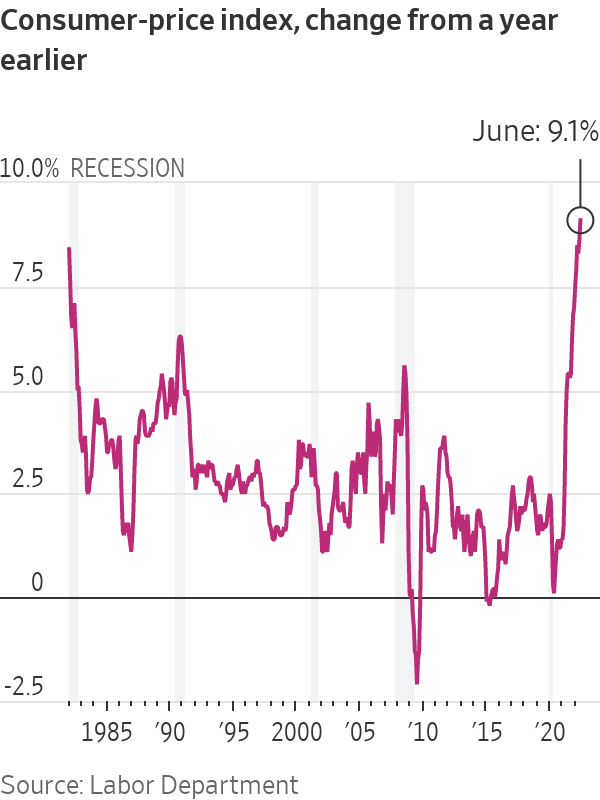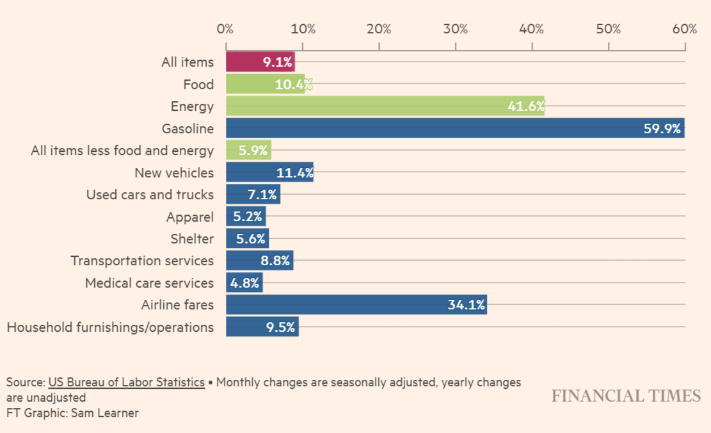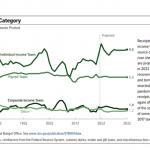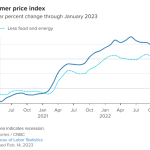U.S. inflation Reaches 9.1% Scorching 41 year high since (1981) fueling recession fears According to Labor Department
The WSJ just reported that U.S. consumer inflation reached 9.1% year-over-year in June, the highest such rate since December 1981, after an unprecedented surge in gas prices according to data published by the Bureau of Labor Statistics. The rate was higher than economists expected, surging past May’s 8.6% consumer price increase. The high inflation, driven by the cost of food and fuel, is likely to precede another 0.75 percentage point increase in federal interest rates when the Federal Reserve meets later this month.
Key takeaways
- Fed Chairman Jerome Powell aims to use rate increases to slow demand and bring down prices, though this also brings with it the risk of a recession.
- The report likely keeps the Fed on track to raise its benchmark interest rate by 0.75 percentage point at its meeting later this month. Stocks dropped and bond yields jumped following the inflation report.
- Still, there are signs that inflation may be starting to cool off. The price of oil, industrial metals, lumber, and other commodities fell at the end of Q2.
- Inflation over the last 18 months has been blamed on a faster-than-expected rebound from pandemic restrictions, increased demand, and low Federal Reserve interest rates.
- The war in Ukraine has contributed to higher energy and food prices worldwide.

(Image credit: WSJ)
The Stock Market did not like higher than expected 41-year high inflation
June CPI data was released at 8:30 a.m today on July 14th, 2022.
- Headline inflation including food & energy
- May 2022 8.6% year-over-year
- June 2022 9.1% y-o-y, 40 year High
- Core CPI, excluding food & energy
- March 2022 6.5% recent peak
- May 2022 6% year-over-year
- June 2022 5.9% y-o-y
On a month-to-month basis, core prices rose 0.7% in June, a bit more than their 0.6% increase in May—a sign of inflationary pressures throughout the economy.
The report showed few signs of relief from higher prices. Costs were up broadly across the economy, with gasoline far outpacing other categories with an 11.2% gain over the prior month. Gasoline prices have been on a downward path in recent weeks. Shelter and food price increases were also major contributors to inflation, the Labor Department said.
Key Background

(Image credit: FT/ David Paul Morris/Bloomberg)
Rising energy prices have helped push inflation readings up to the highest level in decades during the pandemic, and stocks have struggled in recent months as Federal Reserve officials work to combat the surge by unwinding the central bank’s pandemic-era stimulus measures. After rising 27% in 2021, the benchmark S&P 500 has tumbled 20% this year.
Meanwhile, oil prices surged back toward yearly highs of more than $120 per barrel in June amid supply concerns over the summer travel season—adding to those spurred by sanctions against Russia, one of the world’s top oil-producing countries. Prices have since fallen back below $100 per barrel this month, but experts aren’t so sure how long the reprieve will last.
Inflation remains high across the board, particularly for energy prices

(Image credit: Sam Learner FT)
Percent change in Consumer Price Index for all urban consumers, across items.
The Financial Times reported that the market move accelerated after Raphael Bostic, president of the Atlanta Fed, said “everything is in play” in response to a question about the possibility of a 1 percentage point increase. Treasury yields also jumped, with the yield on the two-year note, which moves with interest rate expectations, reaching its highest level since late June. It steadied at 3.2 percent. Policymakers have signaled their intent to raise rates to a level — estimated to be about 3.5 percent — that begins to restrain economic activity by the end of the year. They are seeking to maintain an aggressive approach to tightening monetary policy until there is evidence that monthly inflation readings are decelerating towards a pace more consistent with the Fed’s 2 percent target.
The monthly inflation gains were “broad-based”, according to the BLS, but a 7.5 percent increase in the energy index contributed to almost half of the jump in headline inflation. Petrol prices rose 11.2 percent in June, while food prices were up 1 percent. Prices for new and used vehicles continued their ascent, rising 0.7 percent and 1.6 percent, respectively.
What To Watch For
A recent Forbes article mentioned that in a note to clients Sunday night, Goldman economists said they expect consumer prices to rise more quickly this summer as transportation and health insurance costs continue to surge, pushing core inflation from 5.9% in June to 6.3% in September.
Some experts believe the price surge could last for years. “Consumers may have to live in a world where inflation consistently runs hotter than the previous decade,” LPL Financial chief economist Jeffrey Roach said in a note this month, citing concerns from central bankers like the European Union’s Christine Lagarde, who’s warned there are “growing signs”—including the ongoing war in Ukraine—that suggest “supply shocks hitting the economy could linger” beyond 2024.











